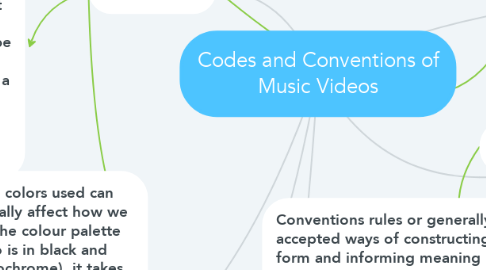Codes and Conventions of Music Videos
by Boom Premsaccha

1. Conventions rules or generally accepted ways of constructing form and informing meaning in media products including story principles, form and structure, generic structures, character and story arcs, cause and effect, point of view, the structuring of time, elements of page layout, paper stock for print, titles and credits sequences, hyperlinking and mounting and framing of images.
2. sound
3. The most common type of sound used in music videos are diegetic and non diegetic
4. Diegetic Sound : - sounds that are seen on screen or off screen. Non-Diegetic Sound : - sounds that are off screen (not taking place from within the frame) and is represented as coming from an outside source
5. Editing
6. Editing is one of the elements that is considered when putting together a music video. The choice to use different paces of cuts are also considered. It is the part of the process where sounds (diegetic and non diegetic), visual effects, clips etc. are put together to form the final outcome.
7. Lighting - The exposure of light can help the audience to recognize the genre of the music. E.g. low key lighting can be used to create a blue mood which is good for music with sad meanings.
8. Hair and Makeup - The hair and makeup will be styled in a certain way to how the rapper wants to be portrayed/arttract the audience.
9. Costume - the choice of outfits used in music videos help represent and inform the genre of the music. Costumes will also give the artists their iconic /recognizable image.
10. Colour - the colors used can psychologically affect how we feel e.g. if the colour palette of the video is in black and white (monochrome), it takes out the emotions and life from the video which could be used in sad songs for example.
11. Sound Parallel is when the music matches the mood of the video. E.g. if the song was had low bpm, then the video would also be slow to go with the mood of the song.
12. Location - The location itself doesn't only suggests where the artists are at but can also reflect the genre of the music as well. E.g. HipHop music videos can be filmed at locations around the street as Hip-Hop evolves from a lot of street culture. Another location could be filmed at a party to reflect the positive energy from the music.
13. The usage of camera angles, movement, and different shots can help create different moods and emotions that the song/artist/band id trying to display.
14. Camera Angles - how the camera is positioned to determine the angle of the shots.
15. High Angle - This is when the camera is pointing down towards the subject. In a way, it makes the subject seem inferior.
16. Eye Level - When the camera is placed at the same height of the artists eyes. It mimics how we see people in real life
17. Low Angle shot - This is when the camera is placed below the actors. It emphasizes the power the subject has over the audience and creates an intimidating image.
18. Camera Movement -
19. Dolly - This is when the camera is generally placed on a rail and can smoothly move along, tracking the subject.
20. Camera shot
21. Close Up - This shot shows the artists face or can show an object that the artist is holding, or something where the camera focuses closely on.
22. Extreme Close Up - This shows the artists face extremely close , this helps the audience to see the facial expressions clearly and can therfore identify emotions/expressions clearly.
23. Long Shot - This shot has a big distance between the subject and the camera. It is usually used to capture the subject within the location.
24. Wide shot - This is where the artist is shown taking up most of the shot but the location/setting is still focused on.
25. Pan - The movement where the camera tilts horizontally. This is often used to follow an object, keeping it in the middle of the frame.
26. Mid Shot - This shows the artist from waist to head, and focuses mainly on the subject alongside capturing the location/setting.
27. Mise en scene
28. Cut in - this shot can be used in music videos to match something that is mentioned in the lyrics.
29. Over the shoulder shot - this is a shot oftenly used to help narrate as it allows the audience to see who the subject is speaking to.
30. Boom 13DR
31. General codes and conventions: Lighting & colour Positioning Setting & locations Facial expressions & body language Sound Mise-en-scene Editing
32. what are codes and conventions?
33. Codes are technical, written and symbolic tools used to construct or suggest meaning in media forms and products. E.g. the use of camera, acting, setting, mise en scene, editing, lighting, sound, special effects, typography, colour, visual composition, text and graphics.
34. Parallel editing : The method of editing that cuts through two or a couple scenes/stories that are happening at the same time.
35. Colour of the video could also be done in the editing stage to help create certain moods that wants to be portrayed within a video
36. CGI (Computer generated images) are also addded to the changes aspects such as backgrounds
37. Jump cuts are usually close up shots that are put together to pass time. Generally it is used when transitioning from one scene to another.
38. Props - Props are used to help with the visuals and the lyrics within the music video. It helps add to the story line and makes the narrative of the scene more realistic.


